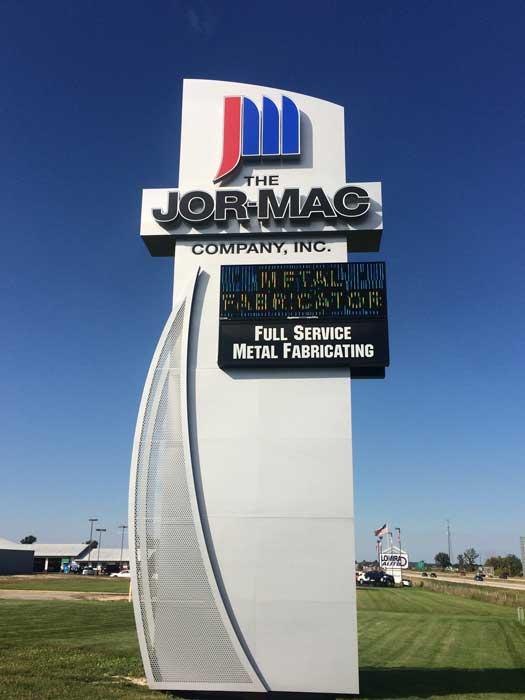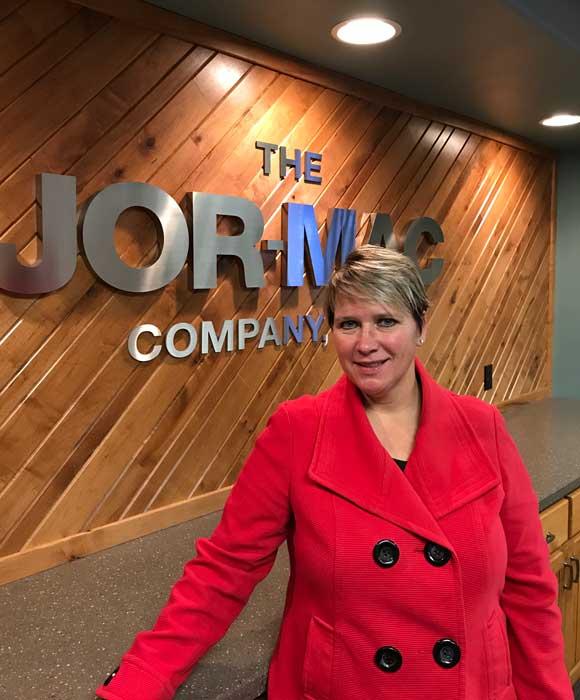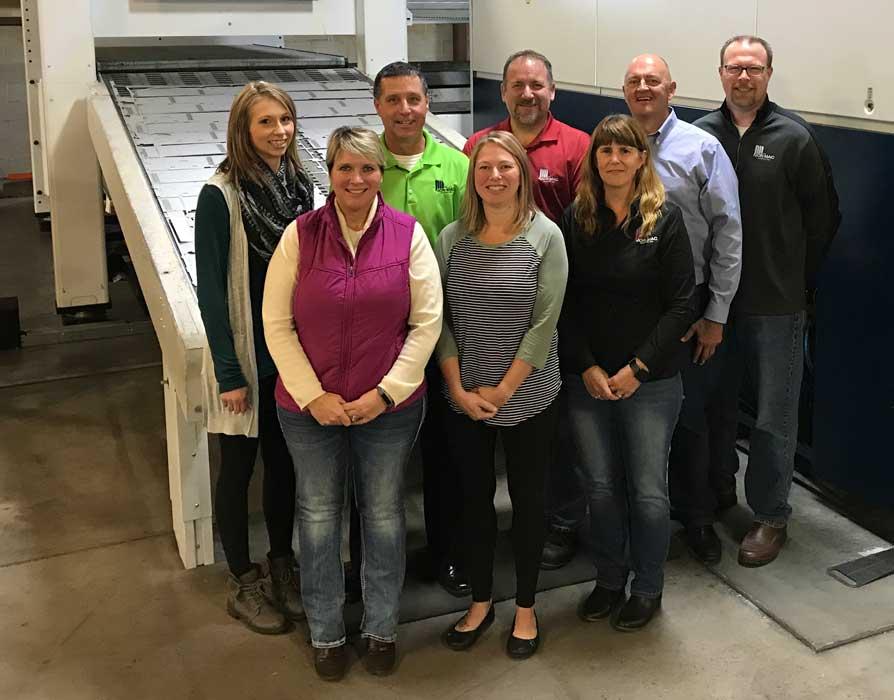Senior Editor
- FMA
- The Fabricator
- FABTECH
- Canadian Metalworking
Categories
- Additive Manufacturing
- Aluminum Welding
- Arc Welding
- Assembly and Joining
- Automation and Robotics
- Bending and Forming
- Consumables
- Cutting and Weld Prep
- Electric Vehicles
- En Español
- Finishing
- Hydroforming
- Laser Cutting
- Laser Welding
- Machining
- Manufacturing Software
- Materials Handling
- Metals/Materials
- Oxyfuel Cutting
- Plasma Cutting
- Power Tools
- Punching and Other Holemaking
- Roll Forming
- Safety
- Sawing
- Shearing
- Shop Management
- Testing and Measuring
- Tube and Pipe Fabrication
- Tube and Pipe Production
- Waterjet Cutting
Industry Directory
Webcasts
Podcasts
FAB 40
Advertise
Subscribe
Account Login
Search
Shaping a metal fabricator to attract the best
How recruiting talent drives decisions at Wisconsin fabricator
- By Tim Heston
- November 30, 2017
- Article
- Shop Management

The LED sign outside Jor-Mac’s facility shows multiple job openings and, most significant, the various shifts that are available.
Drive on Interstate 41 past Lomira, Wis., and you’ll see an LED sign outside The Jor-Mac Co., a custom fabricator that’s one among many in the region. But that sign sets it apart. It displays job openings touting not your usual shift work. Want to work three 12-hour days? A weekend shift and have most of your weekdays free? At Jor-Mac, you have options.
The job opportunities hint at a different kind of metal fabricator, and it becomes immediately apparent when talking with Kelly Sayles, president and general manager of the 140-employee operation. Sayles doesn’t deny that finding good people remains one of the company’s greatest challenges. But she and her management team also have taken concrete steps to attract the best employees they can.
It’s apparently working. This year revenue will be about 30 percent higher than it was last year, and Sayles said she expects the fabricator to maintain 15 percent annual growth over the next three years.
“We’re firing on all cylinders,” said Mike Kwakkel, director of operations. “We’re building a new facility across the street that eventually will mirror what we do now in our current facility. We’re opening up a lot more capacity, which includes our second auto-powder-paint line and the company’s fourth fiber laser with automation.”
If people leave it’s usually within the first few weeks from the date of hire. “They usually leave because they just aren’t committed to our culture,” Sayles said, adding that after that initial period, most choose to stay, and they do so because of the culture.
What defines that culture, exactly? “If something doesn’t serve the customer, it doesn’t have value,” Sayles said. “It’s surprising that not everyone understands this concept.” But she added that if they do, they tend to stay. One employee has been with the company for more than five decades.
How does the company do it? Sources described various techniques that could be grouped into two areas, time and talent, and both are rooted in a solid foundation of modern technology and revenue diversification.
Time
People spend most of their waking hours at work, and yet work is just one puzzle piece of life. Family and community commitments matter, and that’s a big reason that flexible work schedules are such a selling point for many jobs. Some firms, especially tech companies, don’t even institute formal work hours. As long as people get their work done on time, it doesn’t matter when or where they do it.
This makes sense for workers who stare at laptop screens all day, but it would introduce chaos in manufacturing. Still, as Jor-Mac has found, shifts don’t necessarily need to be at conventional times, either.
“We understand that it’s very hard to find people,” Sayles said, “and we found that we needed to work around their schedule. These days, it’s an employees’ market.”

Kelly Sayles joined The Jor-Mac Co. in 2008 as quality manager. In 2010 she became director of operations, and in 2011 she was promoted to president and general manager.
Hence Jor-Mac’s flexible shifts. Some people work five days a week on first shift; some work 36 hours (and get paid for 40) on Sunday, Monday, and Tuesday. Some work 12-hour shifts Wednesday, Thursday, and Friday (and again get paid for 40 hours).
She added, however, that the management team developed these shifts carefully, and each department works specific shifts. In the brake department, for instance, some work Monday through Friday; others work Sunday, Monday, and Tuesday; and still others work Wednesday through Friday. And overtime is still available.
And that’s just one department. Glance at the schedule, and you’d think capacity planning would be chaotic. But look closer, and the logic emerges. The overlaps in the schedule make it easy for everyone to communicate, both within and between shifts. And because the schedules overlap, someone is almost always available to process parts and move them on to the next fabrication step. In this sense, flexible shifts aid part flow.
The schedule also eliminates the typical challenge of finding workers for a conventional second shift—or any work schedule, for that matter, that requires employees to put in hours late into the evening.
“It’s tough to find daycare for your children at 3 o’clock in the morning,” Sayles said, adding that this challenge reduces the available labor pool. And when any fabricator works with a shallow labor pool, troubles arise.
“With our flexible schedules, we were able to hire many people from other area businesses, simply because they saw they could still work full time, but only work three days a week,” said Kwakkel.
He added that this flexible schedule has helped shorten typical lead times from six weeks in 2008 to two or three weeks today. Another key element has been sequentially producing jobs by the due date and not producing ahead just to be able to nest on the laser a little more efficiently.
“We used to push nesting for maximum material utilization,” he recalled. “But then we’d be cutting on a certain gauge everything we needed for the next two or three weeks. That consumed too much capacity, and it prevented us from getting to jobs that had to get out the next day. So now we’re cutting only what we need over the next few days.
“It really just goes back to the proper scheduling of equipment,” he added.
Talent
The flexible schedule wouldn’t work in such a high-product-mix environment if people couldn’t move where needed. Jor-Mac hires workers who specialize in certain processes, of course, but it also has an official position called flex operator in which a person moves where he or she is needed during a shift. It’s well-suited for those who don’t like doing the same thing every day. “We progress these people up the pay scale based on the processes they know,” Kwakkel said. “They’re eager to learn and they want to learn.”

From left, HR Manager Kim Bohman, President and GM Kelly Sayles, Account and Customer Service Manager John Bores, Office Manager Heather Buhalog, Director of Operations Mike Kwakkel, Controller Sharie Stuebs, CEO Paul Luber, and Director of Engineering Jonathan Dowe stand by the company’s newest investment, an 8-kW solid-state laser from TRUMPF.
So how does the company identify someone who would make a good flex operator? As Kim Bohman, HR manager, explained, “During the interview process, we ask [potential hires] what their expectations are of the company, and what would make them stay here long-term. That’s where we often hear that people would like a variety of work.”
What really exemplifies the company’s flexible work environment is when you see Sayles, not sitting in her office poring over reports, but out on the floor operating a brake or hardware insertion press, taking parts off the powder coat line, even on occasion driving parts to a customer’s loading dock.
“There is no hierarchy here,” Sayles said. “It’s OK if I hang parts on the powder coat line, or if I’m over in assembly putting parts in boxes.”
She doesn’t make it a regular practice, of course, but doing it occasionally conveys several messages to people. First, the boss isn’t above any sort of work in the shop. She’s even been seen cleaning out the freezer in the breakroom.
Second, nothing trumps getting quality parts out on time. Sure, Sayles spends most of her days working on the future of the enterprise. But say a job needs to move through the powder coating line to meet a deadline, and the department is short a worker. In this case, strategic planning isn’t the most value-adding work she could be doing. At that moment, she could add more value by hanging parts on the powder coat line.
Sources added that the same thinking goes for anyone in the operation. On certain weeks, for instance, welders may need to leave their stations and head to the hardware insertion department. Yes, Sayles said, they still make a welder’s wage when they insert hardware. So why would the company pay someone as highly skilled and paid as a welder to insert hardware?
“For most of our work, we operate PO [purchase order] by PO,” she said, adding that although the company doesn’t have long-term contracts, it does have long-term relationships. “Some weeks there is just not that much work in welding. We’re not going to waste labor dollars on items that don’t need to be produced, but we also need to keep our folks working and earning.”
That said, the company does have stocking replenishment programs on certain items. These programs help serve customers better (considering the short lead times) and, at least to some extent, help level-load the operation. For one complicated cabinet assembly, the company replenishes a finished-goods buffer that covers 10 days of demand.
Sources emphasized that stocking programs are always done strategically and never to the detriment of orders that need to ship immediately. Still, stocking programs do lessen the effect of demand spikes, when many customers want deliveries all at the same time. In this sense, it helps “even out” the feast and famine nature of metal fabrication, with operations either extremely slow or scrambling to catch up.
Sayles added, however, that this strategy wouldn’t work without another important ingredient to the fabricator’s success: revenue diversification.

Recent equipment investments at Jor-Mac include press brakes and software with offline bend simulation and programming.
Why Revenue Diversification Reigns
Sayles’ metal fabrication career spans more than 30 years. She started in accounting at another Wisconsin fabricator, then applied for and received an inspection position. Soon after she went back to school, got her engineering degree, climbed the ranks to quality manager at other companies, achieved Six Sigma Black Belt credentials, then came to Jor-Mac in 2008 as quality manager. In 2010 she became director of operations, and the very next year was offered the general manager and president’s position.
With her Six Sigma background, she’s a firm believer in continuous improvement and, especially, documented work processes and modern equipment.
“People used to tell me, ‘I don’t really need work instructions because I’ve been doing this for 30 years,’” she said. “Today, with the millennial employees we’re bringing in, you need robust training, topnotch work instructions, and the best equipment. And that’s really our secret sauce here. We’ll train you to do anything. If you come here with a can-do attitude, you’ll win all day long. I’ll take a team player with a positive attitude over people with 20 years of experience who think they know it all.”
When she arrived in 2008, Sayles saw some of the company’s challenges not as a result of poor operations or quality, but as the unintended consequence of high revenue concentration. At the time, 80 percent of the company’s work came from the defense industry, and much of that came from just two customers.
The high revenue concentration exacerbated delivery problems. Jor-Mac would bend over backwards to fulfill orders for its largest customers, but in doing so forced late deliveries to many other smaller customers. The company worked to better the arrangements with its larger clients as the contracts needed updating to reflect current work volumes. But in the end, the parties couldn’t agree on a mutually beneficial production schedule.
“That really was the beginning of our diversification efforts,” Sayles recalled. “We actually told our largest customer that we weren’t going to do business with them anymore because it wasn’t a mutually viable business relationship. It took guts, but at the end of the day, that’s what saved us.”
The reason Jor-Mac made that move—during the Great Recession, no less—was the plethora of smaller customers the fabricator already served. Indeed, severing ties with big customers could have been detrimental without Jor-Mac’s other existing customers.
A perennial challenge in custom fabrication is turning new customers, which usually provide a small amount of work, into large accounts. According to the “2017 Financial Ratios & Operational Benchmarking Survey,” published by the Fabricators & Manufacturers Association, a custom fabricator gains an average of 12 new customers a year, but sales from those new customers make up only 5 percent of revenue. This metric has remained consistent for the past few years.
Jor-Mac in 2008, though, already had many existing customers in many industries, but all of them gave Jor-Mac only a small percentage of their work. “We worked the sales field very hard, and for the most part, we grew sales from customers we already had,” Sayles said. “And it took time. For some, we had to regain their trust because we let them down before, as we kept feeding the big dog.”
The big dog was, of course, those big customers. Now, almost a decade later, Jor-Mac’s revenue pie is colorful, its pieces more evenly divided. Sayles added that the company hasn’t had a single layoff since 2008.
She connected revenue diversification, along with investment in modern equipment, directly with employee retention and success. New equipment includes press brakes programmed offline and an 8-kW solid-state TRUMPF laser with full automation that Jor-Mac installed in November 2017.
Kwakkel added that for revenue diversification to succeed, it requires careful capacity planning, particularly when it comes to fitting new lines of business into production. Kwakkel should know; he spent some years at Mayville, Wis.-based MEC, a very large (No. 1 on The FABRICATOR FAB 40) fabricator known for its production planning. “Now at Jor-Mac, when we win a big project, we look at the implications on work centers, predict the challenges, and work to overcome them from the start.”
Modern manufacturing technology and market diversification effectively give employees the foundation they need to succeed. If those two elements weren’t there, the typical tools for employee engagement wouldn’t have the effect they do.
For instance, every quarter the company gives bonuses based solely on performance metrics shop floor employees can control: dollars per revenue hour, parts per million quality metrics, and the like. If employees work as a team to ship more jobs (that is, generate more revenue) out the door over a quarter, they receive a larger bonus. “It gives them skin in the game,” Sayles said.
“We also do a lot of extra niceties that a lot of companies don’t do anymore,” said Bohman. “We have employee lunches. We hand out turkeys for Thanksgiving and hams for Christmas.”
Still, the effect of these niceties, as well as that skin-in-the-game bonus, would ring hollow if employees had to spend more time away from their families to handle the avalanche of work to “feed the big dog”; or conversely, if the shop had to lay off employees because a major customer reduced its work volume.
So would the flexible work schedule, the comprehensive training, and career opportunities, as would Sayles’ “no hierarchy” message she sends as she lends a hand pulling off parts on the paint line. Employee engagement tools need a foundation to stand on. At Jor-Mac, and perhaps at many other custom fabricators, the right technology and diversification are the critical ingredients.
Photos courtesy of The Jor-Mac Co. Inc., 920-269-8500, www.jor-mac.com.
About the Author

Tim Heston
2135 Point Blvd
Elgin, IL 60123
815-381-1314
Tim Heston, The Fabricator's senior editor, has covered the metal fabrication industry since 1998, starting his career at the American Welding Society's Welding Journal. Since then he has covered the full range of metal fabrication processes, from stamping, bending, and cutting to grinding and polishing. He joined The Fabricator's staff in October 2007.
subscribe now

The Fabricator is North America's leading magazine for the metal forming and fabricating industry. The magazine delivers the news, technical articles, and case histories that enable fabricators to do their jobs more efficiently. The Fabricator has served the industry since 1970.
start your free subscription- Stay connected from anywhere

Easily access valuable industry resources now with full access to the digital edition of The Fabricator.

Easily access valuable industry resources now with full access to the digital edition of The Welder.

Easily access valuable industry resources now with full access to the digital edition of The Tube and Pipe Journal.
- Podcasting
- Podcast:
- The Fabricator Podcast
- Published:
- 04/16/2024
- Running Time:
- 63:29
In this episode of The Fabricator Podcast, Caleb Chamberlain, co-founder and CEO of OSH Cut, discusses his company’s...
- Trending Articles
AI, machine learning, and the future of metal fabrication

Employee ownership: The best way to ensure engagement

Steel industry reacts to Nucor’s new weekly published HRC price

Dynamic Metal blossoms with each passing year

Metal fabrication management: A guide for new supervisors

- Industry Events
16th Annual Safety Conference
- April 30 - May 1, 2024
- Elgin,
Pipe and Tube Conference
- May 21 - 22, 2024
- Omaha, NE
World-Class Roll Forming Workshop
- June 5 - 6, 2024
- Louisville, KY
Advanced Laser Application Workshop
- June 25 - 27, 2024
- Novi, MI


























